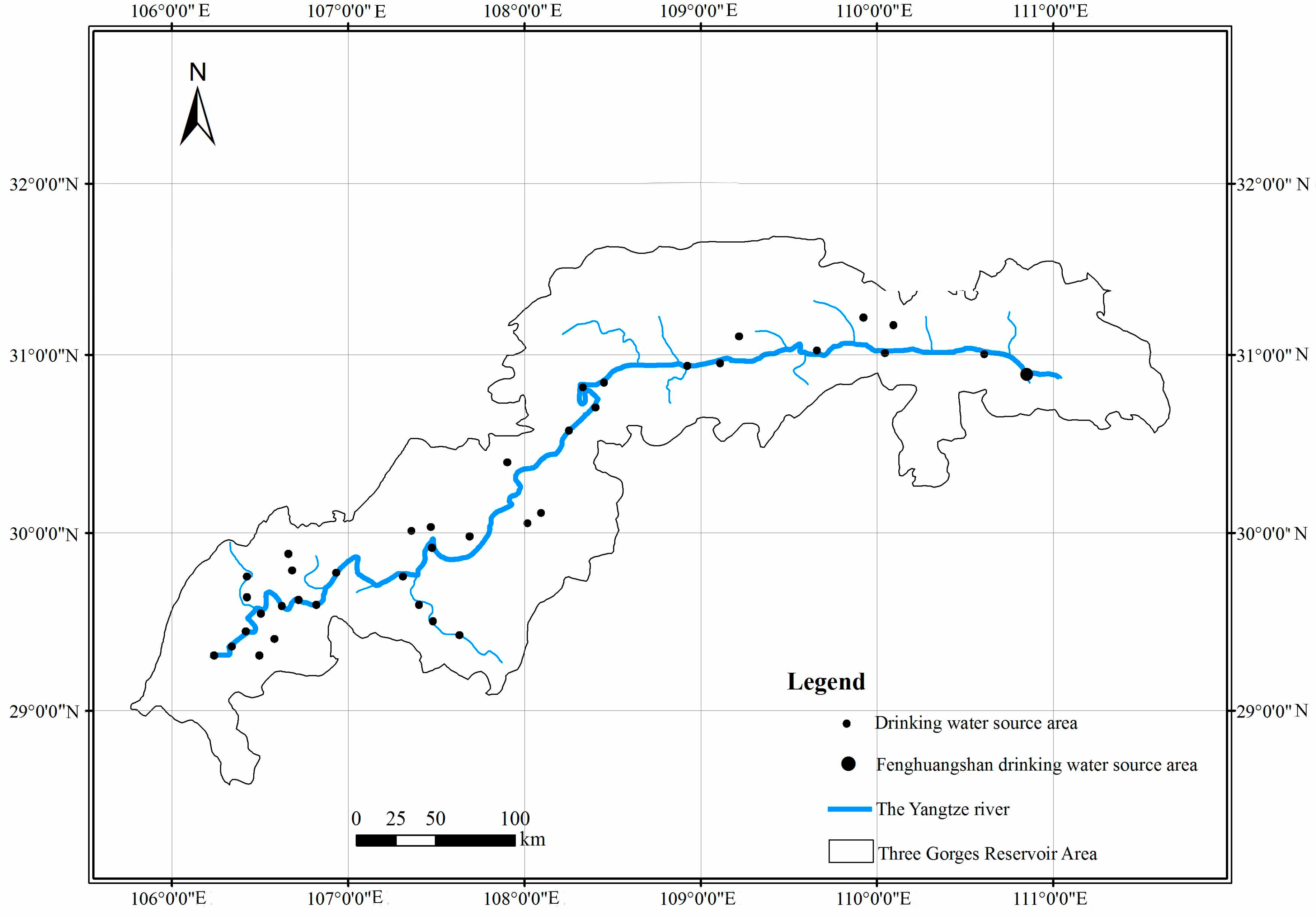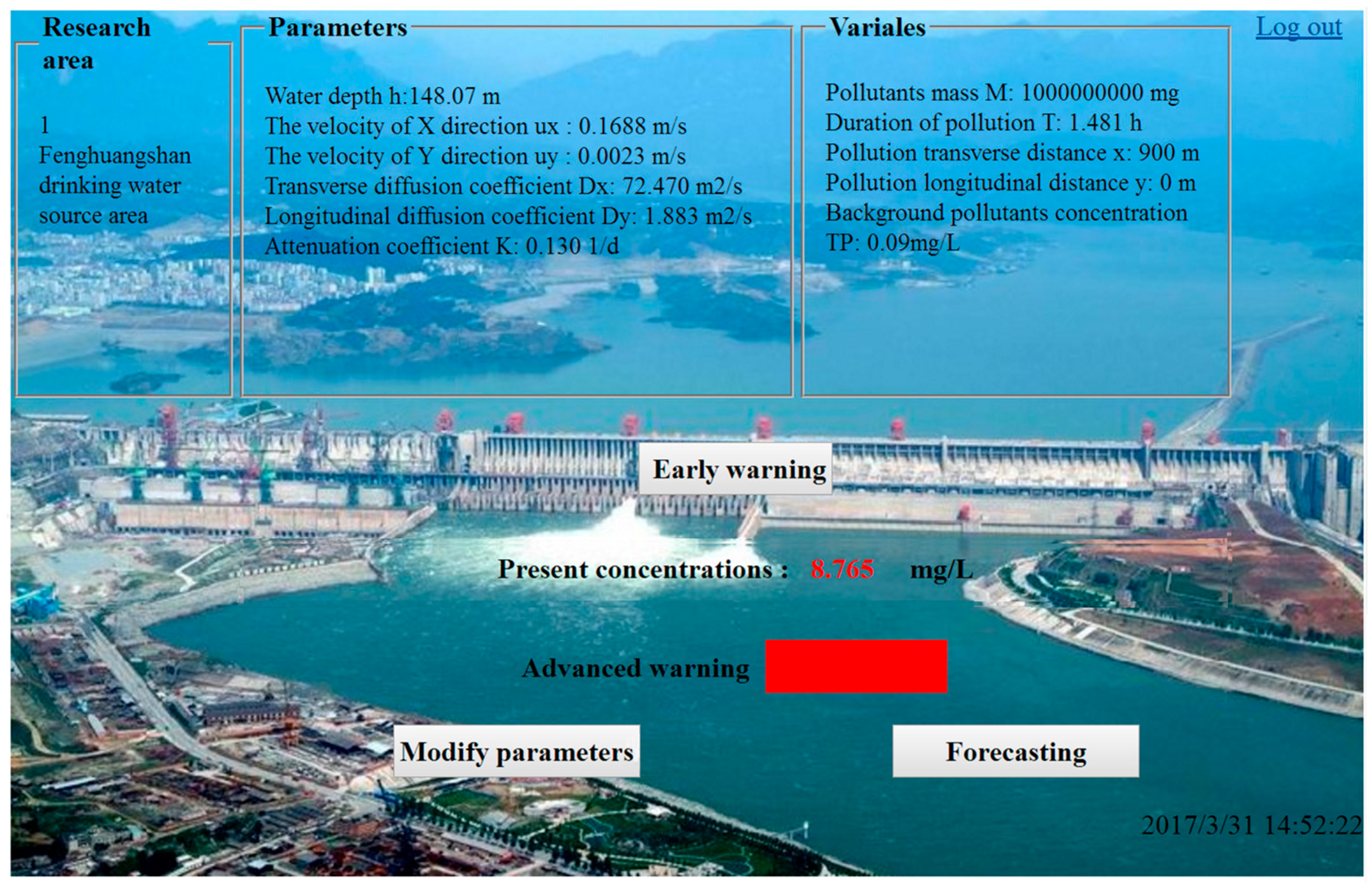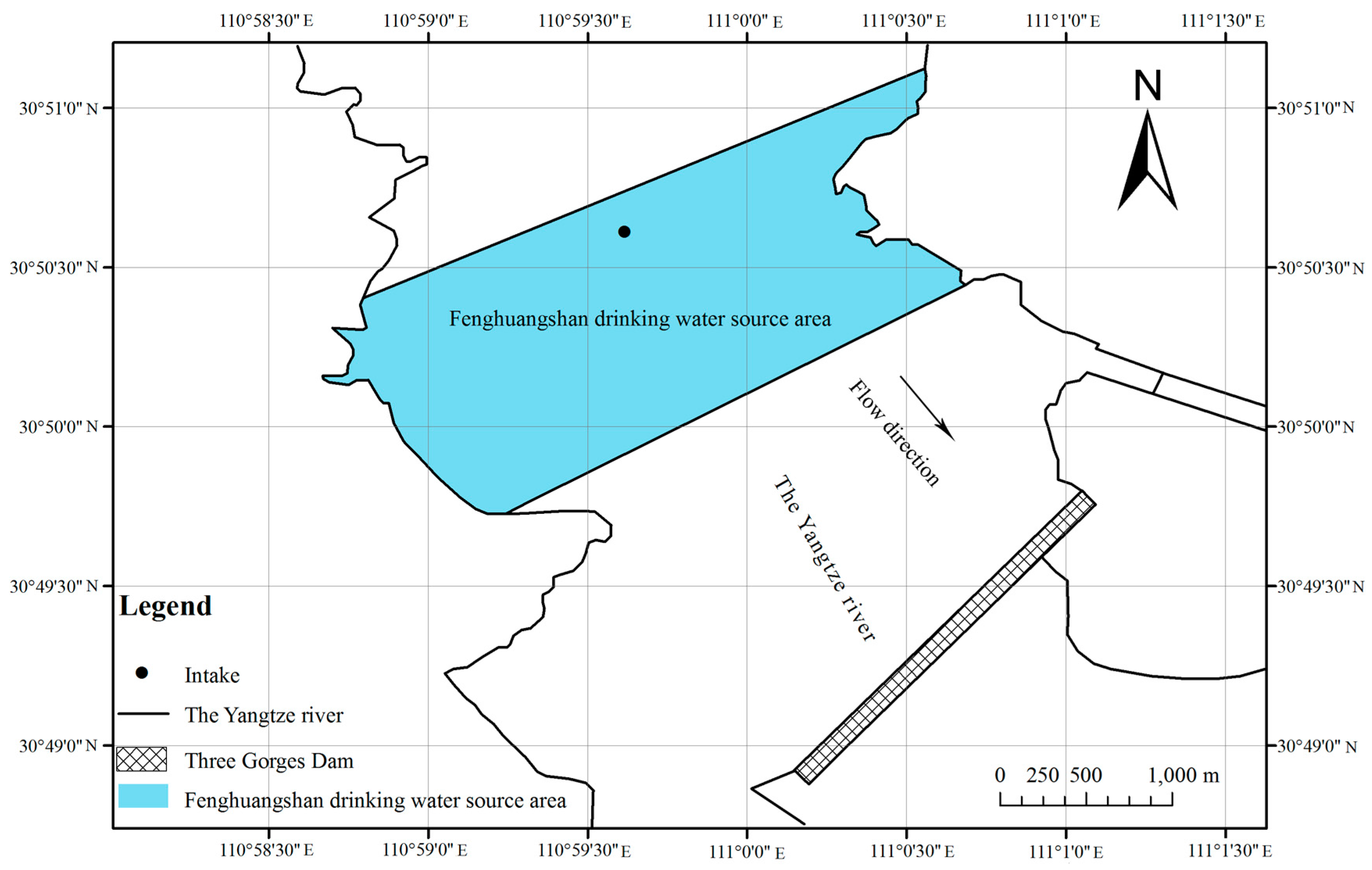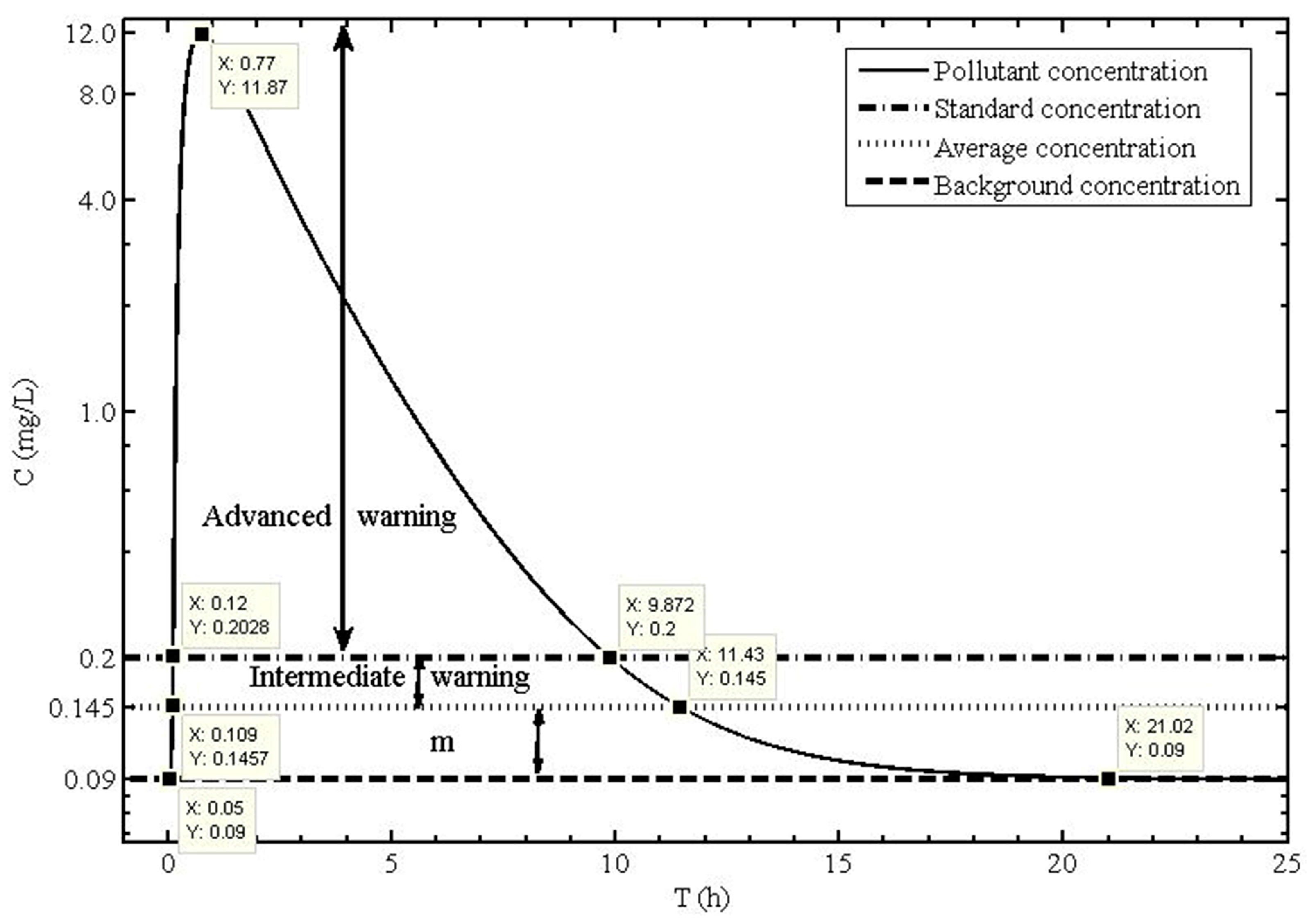Early Warning and Forecasting System of Water Quality Safety for Drinking Water Source Areas in Three Gorges Reservoir Area, China
Abstract
:1. Introduction
2. Materials and Methods
2.1. Study Area
2.2. Methodology
2.2.1. Early Warning and Forecasting Model
2.2.2. Early Warning and Forecasting System
2.3. Data
3. Case Study
4. Results and Discussion
4.1. Early Warning and Forecasting for Water Intake
4.2. Spatial-Temporal Change of the Maximum Concentration
4.3. Spatial-Temporal Change of TP Concentration
4.4. Early Warning and Forecasting for FDWSA
5. Conclusions
Acknowledgments
Author Contributions
Conflicts of Interest
References
- Madouxhumery, A.S.; Dorner, S.; Sauvé, S.; Aboulfadl, K.; Galarneau, M.; Servais, P.; Prévosta, M. The effects of combined sewer overflow events on riverine sources of drinking water. Water Res. 2016, 92, 218–227. [Google Scholar] [CrossRef] [PubMed]
- Farenhorst, A.; Li, R.; Jahan, M.; Tun, H.M.; Mi, R.; Amarakoon, I. Bacteria in drinking water sources of a First Nation reserve in Canada. Sci. Total Environ. 2016, 575, 813–819. [Google Scholar] [CrossRef] [PubMed]
- Scheili, A.; Rodriguez, M.J.; Sadiq, R. Impact of human operational factors on drinking water quality in small systems: An exploratory analysis. J. Clean. Prod. 2016, 133, 681–690. [Google Scholar] [CrossRef]
- Noubactep, C.; Schöner, A.; Woafo, P. Metallic iron filters for universal access to safe drinking water. CLEAN-Soil Air Water 2009, 37, 930–937. [Google Scholar] [CrossRef]
- Wang, H.; Yu, X. A review of the protection of sources of drinking water in China. Nat. Resour. Forum 2014, 38, 99–108. [Google Scholar] [CrossRef]
- Mi, Y.; He, C.; Bian, H.; Cai, Y.; Sheng, L.; Ma, L. Ecological engineering restoration of a non-point source polluted river in Northern China. Ecol. Eng. 2015, 76, 142–150. [Google Scholar] [CrossRef]
- Shi, S.G.; Cao, J.C.; Feng, L.; Liang, W.Y.; Zhang, L.Q. Construction of a technique plan repository and evaluation system based on AHP group decision-making for emergency treatment and disposal in chemical pollution accidents. J. Hazard. Mater. 2014, 276, 200–206. [Google Scholar] [CrossRef] [PubMed]
- Khan, S.; Shahnaz, M.; Jehan, N.; Rehman, S.; Shah, M.T.; Din, I. Drinking water quality and human health risk in Charsadda district, Pakistan. J. Clean. Prod. 2013, 60, 93–101. [Google Scholar] [CrossRef]
- Fernando, D.M.; Tun, H.M.; Poole, J.; Patidar, R.; Li, R.; Mi, R.D.; Amarawansha, G.E.A.; Fernando, W.G.D.; Khafipour, E.; Farenhorst, A.; et al. Detection of antibiotic resistance genes in source and drinking water samples from a first nation community in Canada. Appl. Environ. Microb. 2016, 82, 4767–4775. [Google Scholar] [CrossRef] [PubMed]
- Sahin, O.; Bertone, E.; Beal, C.D. A systems approach for assessing water conservation potential through demand-based water tariffs. J. Clean. Prod. 2017, 148, 773–784. [Google Scholar] [CrossRef]
- Scatena, F.N. Drinking water quality. In Drinking Water from Forests and Grasslands: A Synthesis of the Scientific Literature; General Technical Report SRS-39; Dissmeyer, G.E., Ed.; USDA Forest Service Southern Research Station: Asheville, NC, USA, 2000; Chapter 2; pp. 7–25. [Google Scholar]
- Neary, D.G.; Baillie, B.R. Cumulative Effects Analysis of the Water Quality Risk of Herbicides Used for Site Preparation in the Central North Island, New Zealand. Water 2016, 8, 573. [Google Scholar] [CrossRef]
- Zeng, H.A.; Wu, J.L. Tracing the Nitrate Sources of the Yili River in the Taihu Lake Watershed: A Dual Isotope Approach. Water 2015, 7, 188–201. [Google Scholar] [CrossRef]
- Armstrong, J.S. Evaluating Forecasting Methods. In Principles of Forecasting; Springer: New York, NY, USA, 2001; Volume 30, pp. 443–472. [Google Scholar]
- Franses, P.H. A note on the Mean Absolute Scaled Error. Int. J. Forecast. 2016, 32, 20–22. [Google Scholar] [CrossRef]
- He, Q.; Peng, S.; Zhai, J.; Xiao, H. Development and application of a water pollution emergency response system for the Three Gorges Reservoir in the Yangtze River, China. J. Environ. Sci. 2011, 23, 595–600. [Google Scholar] [CrossRef]
- Zhang, B.; Qin, Y.; Huang, M.X.; Sun, Q.; Li, S.; Wang, L.Q.; Yu, C.H. SD-GIS-based temporal-spatial simulation of water quality in sudden water pollution accidents. Comput. Geosci. 2011, 37, 874–882. [Google Scholar] [CrossRef]
- Kundzewicz, Z.W.; Mata, L.J.; Arnell, N.W.; Döll, P.; Kabat, P.; Jiménez, B. Climate Change 2007—The Physical Science Basis; IPCC: Geneva, Switzerland, 2007. [Google Scholar]
- Li, K.F.; Zhu, C.; Wu, L.; Huang, L.Y. Problems caused by the Three Gorges Dam construction in the Yangtze River basin: A review. Environ. Rev. 2013, 21, 127–135. [Google Scholar] [CrossRef]
- Gleick, P.H.; Cooley, H.; Cohen, M.; Morikawa, M.; Morrison, J.; Palaniappan, M. The World’s Water, 2008–2009: The Biennial Report on Freshwater Resources; Island Press: Washington, DC, USA, 2009. [Google Scholar]
- Wang, J.X.; Bi, Y.H.; Pfister, G.; Henkelmann, B.; Zhu, K.X.; Schramm, K.W. Determination of PAH, PCB, and OCP in water from the three Gorges reservoir accumulated by semipermeable membrane devices (SPMD). Chemosphere 2009, 75, 1119–1127. [Google Scholar] [CrossRef] [PubMed]
- Fu, B.J.; Wu, B.F.; Lu, Y.H.; Xu, Z.H.; Cao, J.H.; Niu, D.; Yang, G.S.; Zhou, Y.M. Three Gorges Project: Efforts and challenges for the environment. Prog. Phys. Geogr. 2010, 34, 741–754. [Google Scholar] [CrossRef]
- Ye, J.Y.; Liu, J.; Ji, F.Y.; Liao, Q.; Wang, X. Analysis and counter measure of water pollution treatment in the City of Chongqing, upstream of the Three Gorges Reservoir in China. In The 2nd International Conference on Bioinformatics and Biomedical Engineering (ICBBE), 2008, Shanghai, China; Engineering in Medicine and Biology Society: Piscataway, NJ, USA, 2008; pp. 3716–3721. [Google Scholar]
- General Administration of Quality Supervision, Inspection and Quarantine of the People’s Republic of China. GB/T 25173–2010, Code of Practice for Computation on Allowable Permitted Assimilative Capacity of Water Bodies; AQSIQ: Beijing, China, 2010.
- Zeng, G.M.; Yuan, X.Z.; Yin, Y.Y.; Yang, C.P. A two-dimensional water-quality model for a winding and topographically complicated river. J. Environ. Manag. 2001, 61, 113. [Google Scholar] [CrossRef] [PubMed]
- Deus, R.; Brito, D.; Mateus, M.; Kenov, I.; Fornaro, A.; Neves, R.; Alves, C.N. Impact evaluation of a pisciculture in the Tucuruí reservoir (Pará, Brazil) using a two-dimensional water quality model. J. Hydrol. 2013, 487, 1–12. [Google Scholar] [CrossRef]
- Martin, J.L. Application of two-dimensional water quality model. J. Environ. Eng. 1988, 114, 317–336. [Google Scholar] [CrossRef]
- Ani, E.C.; Agachi, P.S.; Cristea, M.V. Mathematical models to support pollution counteraction in case of accidents. Environ. Eng. Manag. J. 2012, 16, 143–151. [Google Scholar]
- Ge, X.F.; Hou, D.B.; Zhang, G.X.; Huang, P.J. Cloud Simulation Platform for Water Environment Assessment. Appl. Mech. Mater. 2013, 317, 670–673. [Google Scholar] [CrossRef]
- Chiş, A.; Denker, M.; Gîrba, T.; Nierstrasz, O. Practical domain-specific debuggers using the moldable debugger framework. Comput. Lang. Syst. Struct. 2015, 44, 89–113. [Google Scholar] [CrossRef]
- Morris, M.D. Factorial sampling plans for preliminary computational experiments. Technometrics 1991, 33, 161–174. [Google Scholar] [CrossRef]







| No. | Parameters | Variable | Meanings and Unit |
|---|---|---|---|
| 1 | C | Variables | Pollutant concentrations (mg/L) |
| 2 | t | Variables | time (h) |
| 3 | x | Variables | Longitudinal distance from origin (m) |
| 4 | y | Variables | Transverse distance from origin (m) |
| 5 | M | 1000 | Instantaneous point source item (kg) |
| 6 | H | 147 | Water depth (m) |
| 7 | ux | 0.010–0.100 | Velocity of x direction (m/s) |
| 8 | uy | 0.001–0.005 | Velocity of y direction (m/s) |
| 9 | Dx | 72.470 | Longitudinal diffusion coefficient |
| 10 | Dy | 1.833 | Transverse diffusion coefficient |
| 11 | K | 0.130 | Rate constant of pollutant degradation (s−1) |
| Parameter | TP Concentration Change (mg/L) | ||||
|---|---|---|---|---|---|
| −20% | −10% | 0 | 10% | 20% | |
| K | 0.012 (0.11%) | 0.006 (0.05%) | 0.000 | −0.006 (−0.05%) | −0.012 (−0.11%) |
| Dx | 0.861 (7.71%) | 0.410 (3.67%) | 0.000 | −0.373 (−3.34%) | −0.714 (−6.40%) |
| Dy | 1.295 (11.60%) | 0.592 (5.30%) | 0.000 | −0.051 (−0.46%) | −0.958 (−8.58%) |
| Ux | −1.116 (−10.00%) | −0.535 (−4.79%) | 0.000 | 0.479 (4.29%) | 0.892 (7.99%) |
| Uy | 0.018 (0.16%) | 0.009 (0.08%) | 0.000 | −0.010 (−0.09%) | −0.022 (−0.20%) |
| Stage | Level of Early Warning | TP Concentration (mg/L) | Time (after the Accident) (h) | Duration (h) |
|---|---|---|---|---|
| 1 | Primary warning | 0.090–0.145 | 0.050–0.109 | 0.059 |
| 2 | Intermediate warning | 0.145–0.200 | 0.109–0.120 | 0.011 |
| 3 | Advanced warning | 0.200–3.804 | 0.120–9.872 | 9.752 |
| 4 | Intermediate warning | 0.200–0.145 | 9.872–11.430 | 1.558 |
| 5 | Primary warning | 0.145–0.009 | 11.430–21.020 | 9.590 |
| Distance from the Upper Boundary to the Maximum Concentration Point (m) | Maximum Concentration (mg/L) | Time after the Accident (h) |
|---|---|---|
| 0 | 0.090 | a1 0.040 |
| 0 | 8.765 | a2 1.481 |
| 100 | 7.891 | 1.646 |
| 200 | 7.176 | 1.810 |
| 300 | 6.580 | 1.975 |
| 400 | 6.075 | 2.139 |
| 500 | 5.643 | 2.304 |
| 600 | 5.268 | 2.468 |
| 700 | 4.940 | 2.633 |
| 800 | 4.651 | 2.798 |
| 900 | 4.393 | 2.962 |
| 1000 | 4.163 | 3.127 |
| 1100 | 3.956 | b1 3.291 |
| 1100 | 0.090 | b2 24.030 |
| Stage | Early Warning Level | Concentration (mg/L) | Time (after the Accident) (h) | Duration (h) |
|---|---|---|---|---|
| 1 | Primary warning | 0.090–0.145 | 0.040–0.087 | 0.047 |
| 2 | Intermediate warning | 0.145–0.200 | 0.087–0.096 | 0.009 |
| 3 | Advanced warning | 0.200–3.804 | 0.0960–11.960 | 11.864 |
| 4 | Intermediate warning | 0.200–0.145 | 11.960–13.630 | 1.670 |
| 5 | Primary warning | 0.145–0.009 | 13.630–24.030 | 10.400 |
© 2017 by the authors. Licensee MDPI, Basel, Switzerland. This article is an open access article distributed under the terms and conditions of the Creative Commons Attribution (CC BY) license (http://creativecommons.org/licenses/by/4.0/).
Share and Cite
Ding, X.; Zhang, J.; Jiang, G.; Zhang, S. Early Warning and Forecasting System of Water Quality Safety for Drinking Water Source Areas in Three Gorges Reservoir Area, China. Water 2017, 9, 465. https://doi.org/10.3390/w9070465
Ding X, Zhang J, Jiang G, Zhang S. Early Warning and Forecasting System of Water Quality Safety for Drinking Water Source Areas in Three Gorges Reservoir Area, China. Water. 2017; 9(7):465. https://doi.org/10.3390/w9070465
Chicago/Turabian StyleDing, Xiaowen, Jianjie Zhang, Guihong Jiang, and Shanghong Zhang. 2017. "Early Warning and Forecasting System of Water Quality Safety for Drinking Water Source Areas in Three Gorges Reservoir Area, China" Water 9, no. 7: 465. https://doi.org/10.3390/w9070465




